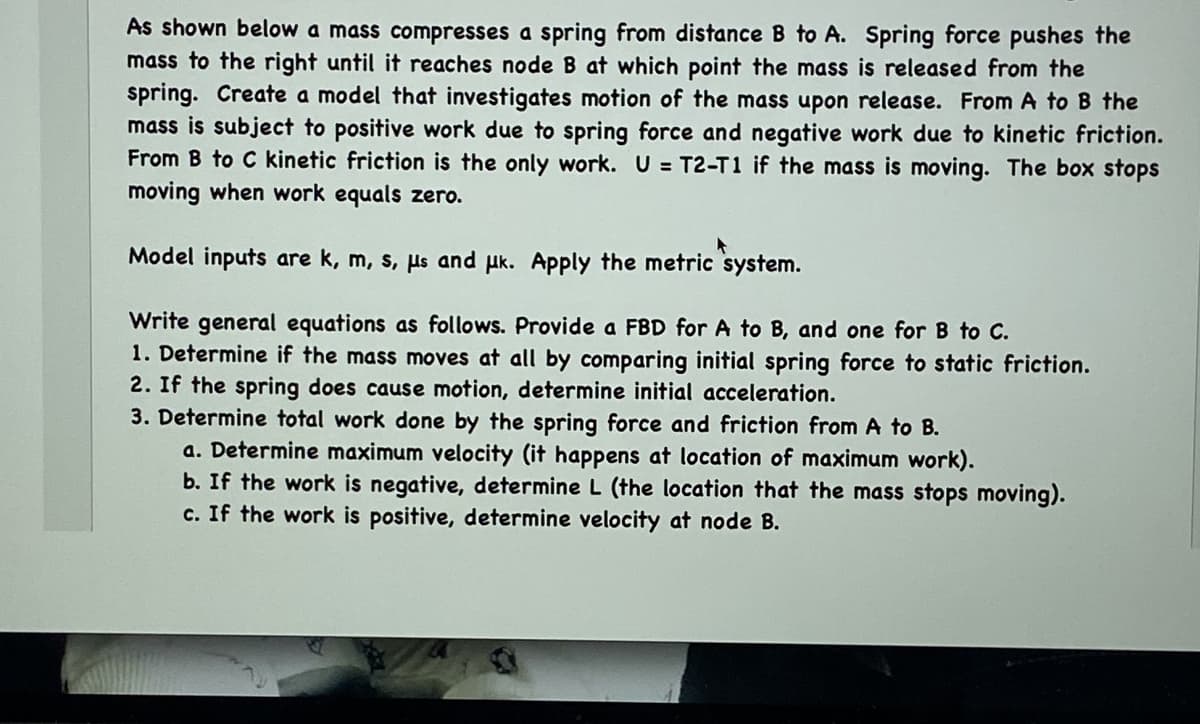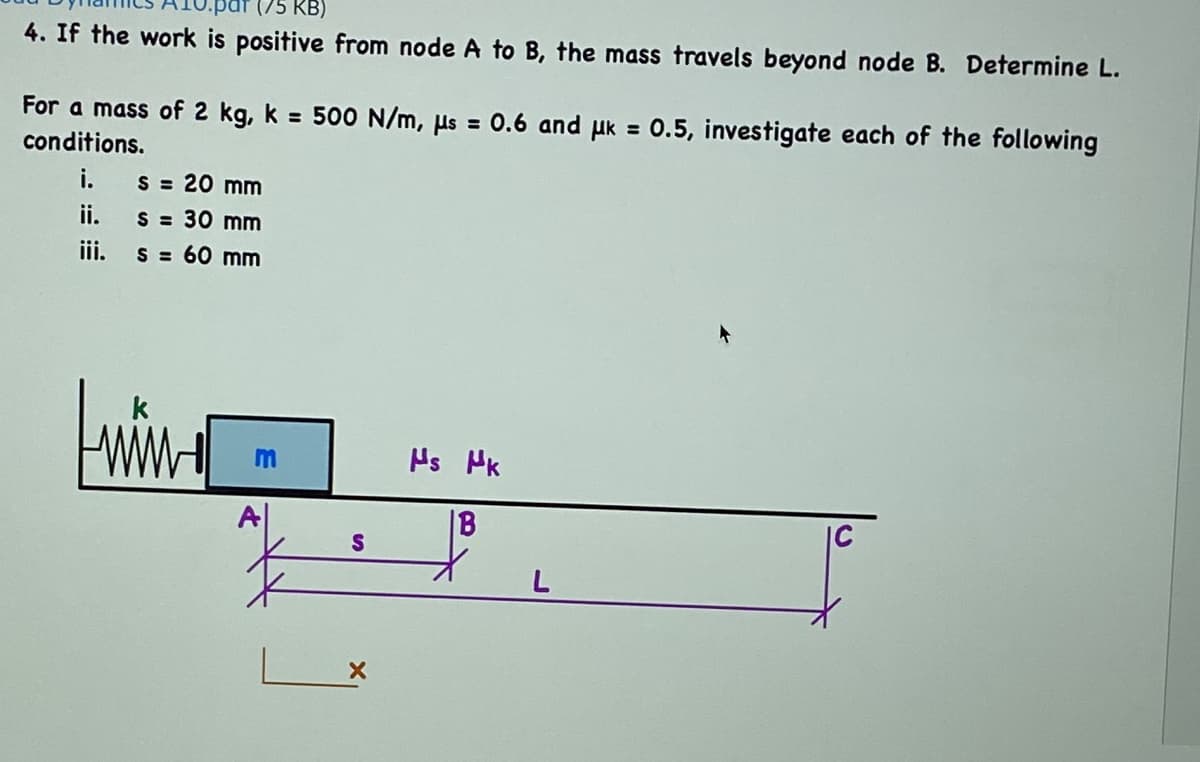As shown below a mass compresses a spring from distance B to A. Spring force pushes the mass to the right until it reaches node B at which point the mass is released from the spring. Create a model that investigates motion of the mass upon release. From A to B the mass is subject to positive work due to spring force and negative work due to kinetic frictio From B to C kinetic friction is the only work. U = T2-T1 if the mass is moving. The box stop moving when work equals zero. Model inputs are k, m, s, µs and uk. Apply the metric system. Write general equations as follows. Provide a FBD for A to B, and one for B to C. 1. Determine if the mass moves at all by comparing initial spring force to static friction. 2. If the spring does cause motion, determine initial acceleration. 3. Determine total work done by the spring force and frictien frem A to R
As shown below a mass compresses a spring from distance B to A. Spring force pushes the mass to the right until it reaches node B at which point the mass is released from the spring. Create a model that investigates motion of the mass upon release. From A to B the mass is subject to positive work due to spring force and negative work due to kinetic frictio From B to C kinetic friction is the only work. U = T2-T1 if the mass is moving. The box stop moving when work equals zero. Model inputs are k, m, s, µs and uk. Apply the metric system. Write general equations as follows. Provide a FBD for A to B, and one for B to C. 1. Determine if the mass moves at all by comparing initial spring force to static friction. 2. If the spring does cause motion, determine initial acceleration. 3. Determine total work done by the spring force and frictien frem A to R
Elements Of Electromagnetics
7th Edition
ISBN:9780190698614
Author:Sadiku, Matthew N. O.
Publisher:Sadiku, Matthew N. O.
ChapterMA: Math Assessment
Section: Chapter Questions
Problem 1.1MA
Related questions
Question

Transcribed Image Text:As shown below a mass compresses a spring from distance B to A. Spring force pushes the
mass to the right until it reaches node B at which point the mass is released from the
spring. Create a model that investigates motion of the mass upon release. From A to B the
mass is subject to positive work due to spring force and negative work due to kinetic friction.
From B to C kinetic friction is the only work. U = T2-T1 if the mass is moving. The box stops
moving when work equals zero.
Model inputs are k, m, s, µs and uk. Apply the metric system.
Write general equations as follows. Provide a FBD for A to B, and one for B to C.
1. Determine if the mass moves at all by comparing initial spring force to static friction.
2. If the spring does cause motion, determine initial acceleration.
3. Determine total work done by the spring force and friction from A to B.
a. Determine maximum velocity (it happens at location of maximum work).
b. If the work is negative, determine L (the location that the mass stops moving).
c. If the work is positive, determine velocity at node B.

Transcribed Image Text:(75 KB)
4. If the work is positive from node A to B, the mass travels beyond node B. Determine L.
For a mass of 2 kg, k = 500 N/m, µs = 0.6 and uk = 0.5, investigate each of the following
conditions.
i.
S = 20 mm
ii.
S = 30 mm
ii.
S = 60 mm
Hs HK
|B
Expert Solution
This question has been solved!
Explore an expertly crafted, step-by-step solution for a thorough understanding of key concepts.
Step by step
Solved in 6 steps with 1 images

Knowledge Booster
Learn more about
Need a deep-dive on the concept behind this application? Look no further. Learn more about this topic, mechanical-engineering and related others by exploring similar questions and additional content below.Recommended textbooks for you

Elements Of Electromagnetics
Mechanical Engineering
ISBN:
9780190698614
Author:
Sadiku, Matthew N. O.
Publisher:
Oxford University Press

Mechanics of Materials (10th Edition)
Mechanical Engineering
ISBN:
9780134319650
Author:
Russell C. Hibbeler
Publisher:
PEARSON

Thermodynamics: An Engineering Approach
Mechanical Engineering
ISBN:
9781259822674
Author:
Yunus A. Cengel Dr., Michael A. Boles
Publisher:
McGraw-Hill Education

Elements Of Electromagnetics
Mechanical Engineering
ISBN:
9780190698614
Author:
Sadiku, Matthew N. O.
Publisher:
Oxford University Press

Mechanics of Materials (10th Edition)
Mechanical Engineering
ISBN:
9780134319650
Author:
Russell C. Hibbeler
Publisher:
PEARSON

Thermodynamics: An Engineering Approach
Mechanical Engineering
ISBN:
9781259822674
Author:
Yunus A. Cengel Dr., Michael A. Boles
Publisher:
McGraw-Hill Education

Control Systems Engineering
Mechanical Engineering
ISBN:
9781118170519
Author:
Norman S. Nise
Publisher:
WILEY

Mechanics of Materials (MindTap Course List)
Mechanical Engineering
ISBN:
9781337093347
Author:
Barry J. Goodno, James M. Gere
Publisher:
Cengage Learning

Engineering Mechanics: Statics
Mechanical Engineering
ISBN:
9781118807330
Author:
James L. Meriam, L. G. Kraige, J. N. Bolton
Publisher:
WILEY